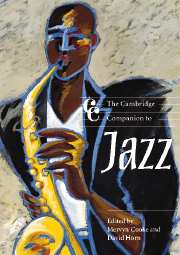The word jazz
Published online by Cambridge University Press: 28 September 2011
Summary
Jazz is a construct. Nothing can be called jazz simply because of its ‘nature’. Musical genres such as the military march, opera and reggae are relatively homogeneous and easy to identify. By contrast, the term jazz is routinely applied to musics that have as little in common as an improvisation by Marilyn Crispell and a 1923 recording by King Oliver and his Creole Jazz Band. Developed well outside the more carefully regulated institutions of American culture, early jazz, proto-jazz or Ur-jazz was performed by people from an extremely wide variety of backgrounds. Many styles of playing were mixed together and others were split off and acquired different names. If today we call something jazz, it has much more to do with the utterances of critics, journalists, record companies and club owners than with the music itself.
Those who have been most devoted to defining the music and to discriminating between true jazz and false jazz often rely upon tautologies and ad hominem arguments. The esteemed poet and jazz writer Philip Larkin, for example, once wrote:
I like jazz to be jazz. A. E. Housman said he could recognize poetry because it made his throat tighten and his eyes water: I can recognize jazz because it makes me tap my foot, grunt affirmative exhortations, or even get up and caper around the room. If it doesn't do this, then however musically interesting or spiritually adventurous or racially praiseworthy it is, it isn't jazz. If that's being a purist, then I'm a purist.
[Larkin 1985, 175]- Type
- Chapter
- Information
- The Cambridge Companion to Jazz , pp. 1 - 6Publisher: Cambridge University PressPrint publication year: 2003
- 3
- Cited by

